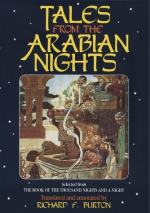[FN#349] This is a mere phrase for our “dying of laughter”: the queen was on her back. And as Easterns sit on carpets, their falling back is very different from the same movement off a chair.
[FN#350] Arab. “Ismid,” the eye-powder before noticed.
[FN#351] When the Caliph (e.g. Al-Ta’i li’llah) bound a banner to a spear and handed it to an officer, he thereby appointed him Sultan or Viceregent.
[FN#352] Arab. “Shaib al-inghaz"=lit. a gray beard who shakes head in disapproval.
[FN#353] Arab. “Ayat” = the Hebr. “Ototh,” signs, wonders or Koranic verses.
[FN#354] The Chapter “Al-Ikhlas” i.e. clearing (oneself from any faith but that of Unity) is No. cxii. and runs thus:—
Say, He is the One God!
The sempiternal God,
He begetteth not, nor is He begot,
And unto Him the like is not.
It is held to be equal in value to one-third of the Koran, and is daily used in prayer. Mr. Rodwell makes it the tenth.
[FN#355] The Lady Budur shows her noble blood by not objecting to her friend becoming her Zarrat (sister-wife). This word is popularly derived from “Zarar"=injury; and is vulgarly pronounced in Egypt “Durrah” sounding like Durrah = a parrot (see Burckhardt’s mistake in Prov. 314). The native proverb says, “Ayshat al-durrah murrah,” the sister-wife hath a bitter life. We have no English equivalent; so I translate indifferently co-wife, co-consort, sister-wife or sister in wedlock.
[FN#356] Lane preserves the article “El-Amjad” and “El-As’ad;” which is as necessary as to say “the John” or “the James,” because neo-Latins have “il Giovanni” or “il Giacomo.” In this matter of the article, however, it is impossible to lay down a universal rule: in some cases it must be preserved and only practice in the language can teach its use. For instance, it is always present in Al-Bahrayn and al-Yaman; but not necessarily so with Irak and Najd.
[FN#357] It is hard to say why this ugly episode was introduced. It is a mere false note in a tune pretty enough.
[FN#358] The significance of this action will presently appear.
[FN#359] An “Hadis.”
[FN#360] Arab. “Sabb” = using the lowest language of abuse. chiefly concerning women-relatives and their reproductive parts.
[FN#361] The reader will note in the narration concerning the two Queens the parallelism of the Arab’s style which recalls that of the Hebrew poets. Strings of black silk are plaited into the long locks (an “idiot-fringe” being worn over the brow) because a woman is cursed “who joineth her own hair to the hair of another” (especially human hair). Sending the bands is a sign of affectionate submission; and, in extremes” cases the hair itself is sent.
[FN#362] i.e., suffer similar pain at the spectacle, a phrase often occurring.
[FN#363] i.e., when the eye sees not, the heart grieves not.




